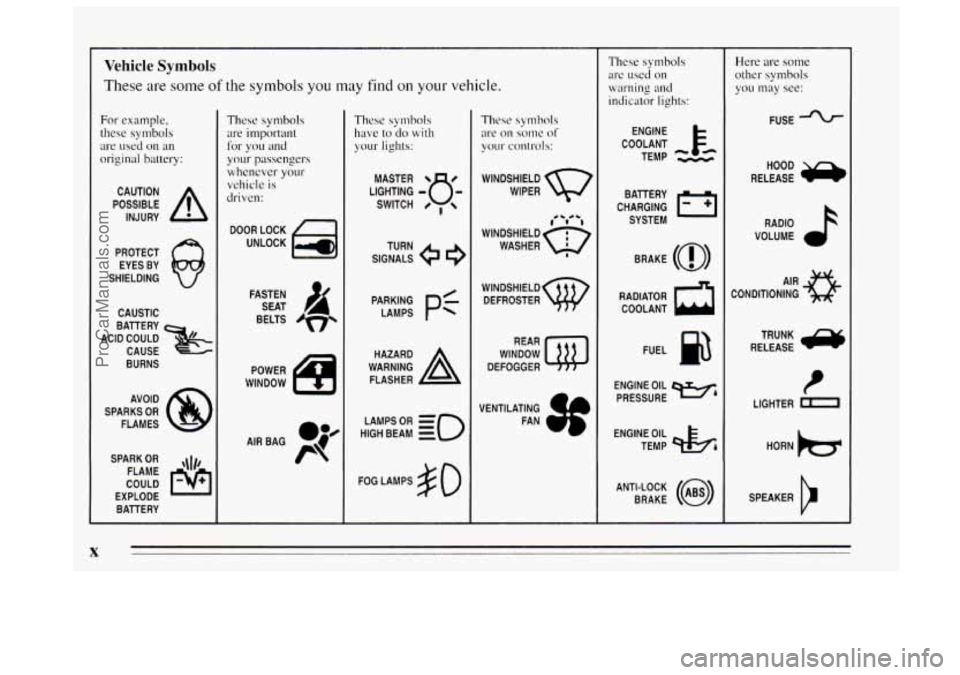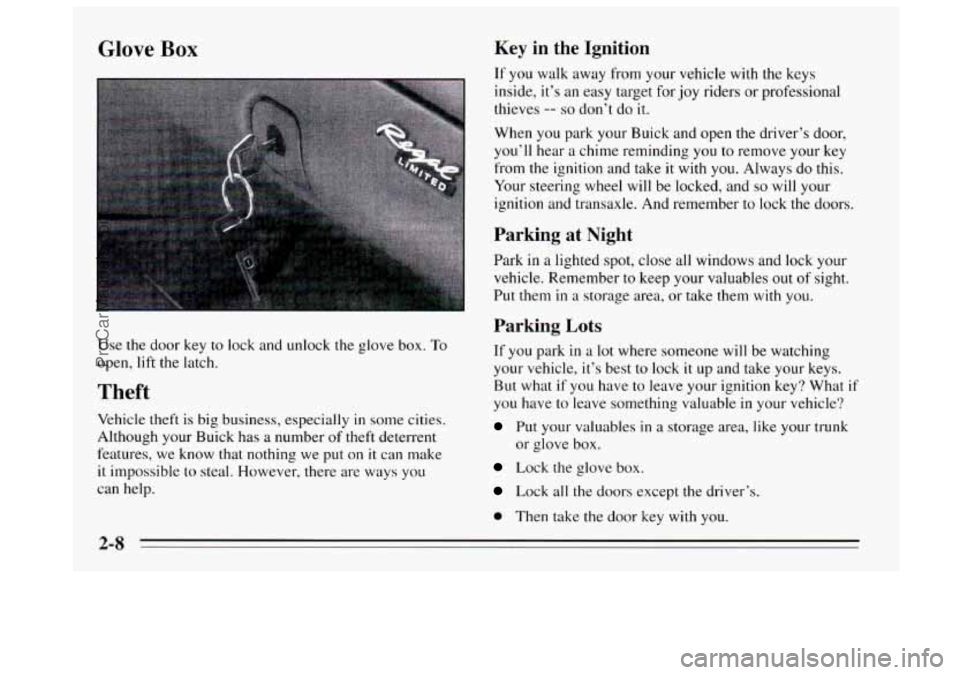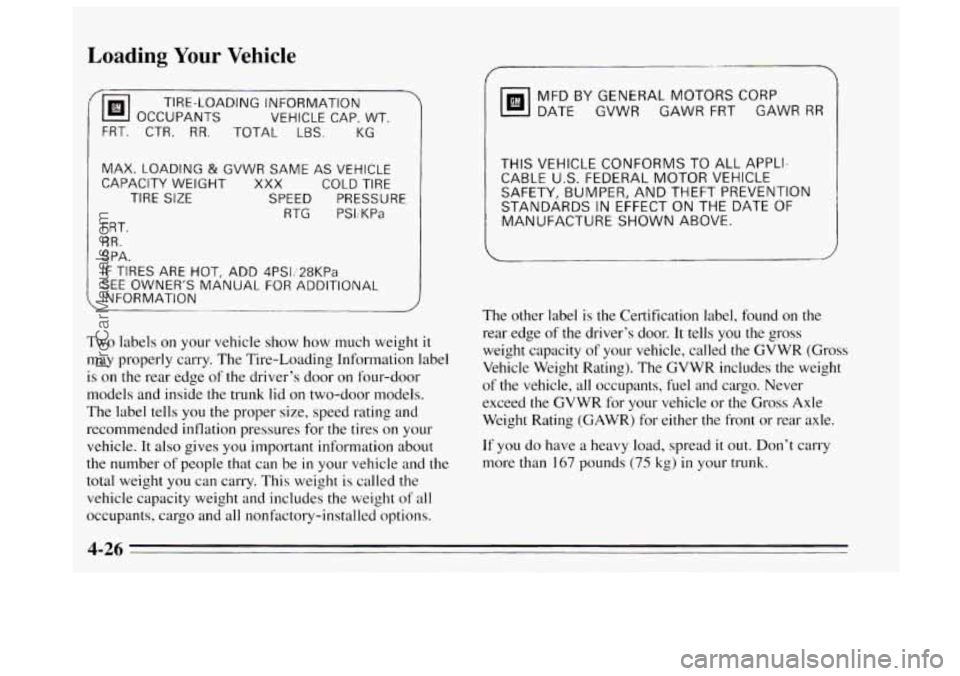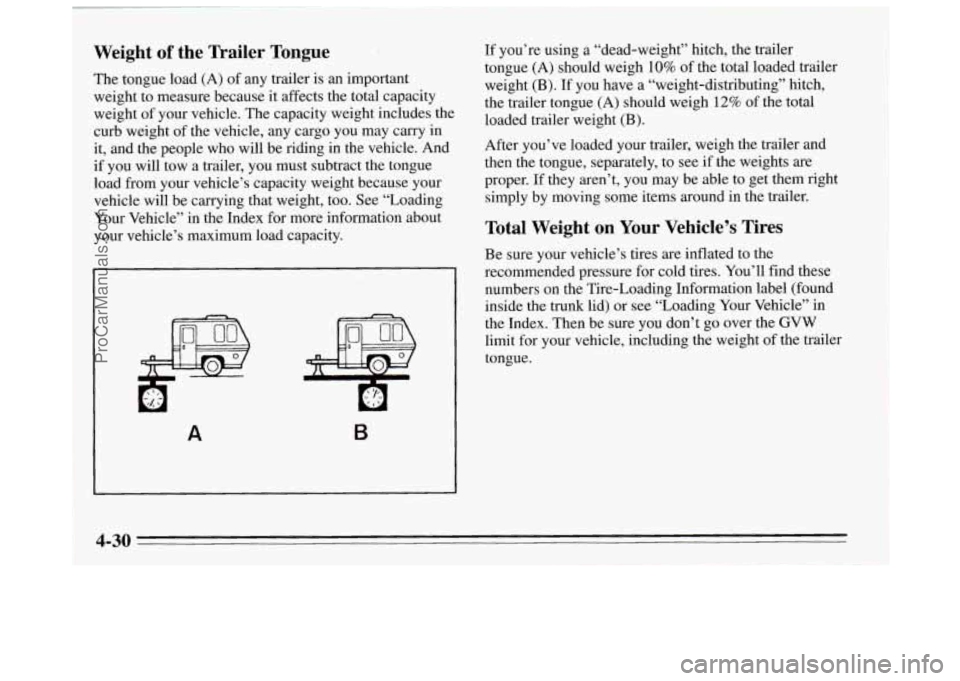Page 12 of 340

Vehicle Symbols
These are some of the symbols you may find on your vehicle.
For example,
these symbols
are used
on an
original battery:
POSSIBLE A
CAUTION
INJURY
PROTECT EYES BY
SHIELDING
CAUSTIC
BATTERY
CAUSE
BURNS
ACID COULD
x
AVOID
SPARKS
OR
FLAMES
SPARK
OR ,\I/,
COULD FLAME
EXPLODE BATTERY
These symbols are important
for you and
your passengers whenever your
vehicle
is
driven:
DOOR LOCK
UNLOCK
BELTS
4
These symbols
have
to do with
your lights:
SIGNALS e
TURN
POWER
WINDOW
HIGH LAMPSoR BEAM
= =o
FOG LAMPS $0
These symbols
are on
some of
your controls:
WINDSHIELD
WIPER
1. *td -1
WINDSHIELD c)
WASHER a
WINDSHIELD DEFROSTER
WINDOW
DEFOGGER
VENTILATING FAN
These symbols
are used on
warning and
indicator lights:
COOLANT F-
TEMP --
ENGINE
CHARGING BATTERY
SYSTEM
BRAKE
(0)
RADIATOR COOLANT
a
FUEL
ENGINE OIL
PRESSURE
w4
TEMP OIL 4%
ANTI-LOCK (@)
BRAKE
Here are some other symbols
you may
see:
FUSE
RADIO
VOLUME
AIR
CONDITIONING
TRUNK
e
RELEASE
t
LIGHTER n
SPEAKER
b
X
ProCarManuals.com
Page 67 of 340

Remote Lock Control (Option)
If your Buick has this option, you can lock and unlock your
doors or unlock your trunk from
up to 30 feet (9 m) away
using the key chain transmitter supplied with your vehicle.
Your Remote Lock Control operates
on a radio
frequency subject to Federal Communications
Commission (FCC) Rules.
This device complies
with Part 15 of the FCC Rules.
Operation is subject
to the following two conditions:
(1 ) This device may not cause harmful interference, and
(2) This device must accept any interference received,
including interference that may cause undesired operation.
Should interference to this system occur,
try this:
Check to determine if battery replacement is necessary.
See the instructions on battery replacement.
0 Check the distance. You may be too far from your
vehicle. This product has a maximum range.
0 Check the location. Other vehicles or objects may be
blocking the signal.
0 See your Buick dealer or a qualified technician for service.
Changes
or modifications to this system by other than an
authorized service facility could void authorization to
use this equipment.
Operation
Press UNLOCK once to unlock the driver’s door. Press
UNLOCK again within five seconds to unlock all the
doors. The interior lamps
will come on (see “Illuminated
Entry”
in the Index for more details).
To lock all doors, press DOOR. To unlock the trunk,
press the trunk symbol on the transmitter. The
trunk will
only unlock if your transaxle is in PARK (P) and your
ignition is
in LOCK, OFF or ACC.
2-5
ProCarManuals.com
Page 69 of 340
Trunk Lock
To unlock the trunk from
the outside, insert the door
key and turn it. You can also
use the Remote Lock
Control, if your vehicle has
this option.
Remote Trunk Release (Option)
Press the button behind the glove box door to unlock
the trunk from inside your
vehicle. Your transaxle shift
lever must
be in PARK (P).
Remember that your trunk can be opened at any time
using this lock release. Be sure to lock your doors.
2-7
ProCarManuals.com
Page 70 of 340

Glove Box Key in the Ignition
If you walk away from your vehicle with the keys
inside, it’s an easy target for joy riders or professional
thieves
-- so don’t do it.
When you park your Buick and open the driver’s door,
you’ll hear a chime reminding you to remove your key
from the ignition and take it with
you. Always do this.
Your steering wheel will be locked, and
so will your
ignition and transaxle. And remember to lock the doors.
Parking at Night
Park in a lighted spot, close all windows and lock your
vehicle. Remember to keep your valuables out of sight.
Put them in
a storage area, or take them with you.
Parking Lots
Use the door key to lock and unlock the glove box. To
open, lift the latch.
Theft
Vehicle theft is big business, especially in some cities.
Although your Buick has
a number of theft deterrent
features, we know that nothing we put on
it can make
it impossible to steal. However, there are ways you
can help.
If you park in a lot where someone will be watching
your vehicle, it’s best to lock it
up and take your keys.
But what if
you have to leave your ignition key? What if
you have to leave something valuable in your vehicle?
Put your valuables in a storage area, like your trunk
or glove box.
Lock the glove box.
Lock all the doors except the driver’s.
0 Then take the door key with you.
2-8
ProCarManuals.com
Page 99 of 340
Convenience Net (Option)
Your vehicle may have a convenience net. You’ll see it
on the back wall of the trunk.
Put small loads, like grocery bags, behind the net. It can
help keep them from falling over during sharp turns or
quick starts and
stops.
The net isn’t for larger, heavier loads. Store them in the
trunk as far forward as you can.
You can unhook the net so that it will lie flat when
you’re not using it.
Storage and Compartments
Storage Armrest
To use the storage area, fold
down the armrest. Press the
latch on the front edge and
pull
up. To use the
cupholder, flip it forward.
You may also have an
armrest in the rear. It may
have a storage area and
cupholders.
2-37
ProCarManuals.com
Page 160 of 340
Winter Driving
Here are some tips for winter driving:
0 Have your Buick in good shape for winter. Be sure
0 You may want to put winter emergency supplies in
your
engine coolant
mix is correct.
your trunk. Include
an ice scraper, a small brush or broom,
a supply
of windshield washer fluid, a rag, some winter outer
clothing, a small shovel, a flashlight, a red cloth,
and a
couple of reflective warning triangles. And, if you will
be driving under severe conditions, include a small bag
of sand, a piece of old carpet
or a couple of burlap bags
to help provide traction. Be sure you properly secure
these items in your vehicle.
4-22
ProCarManuals.com
Page 164 of 340

Loading Your Vehicle
OCCUPANTS VEHICLE CAP. WT.
TIRE-LOADING INFORMATION
I FRT. CTR. RR.
TOTAL LBS. KG
MAX.
LOADING & GVWR SAME AS VEHICLE
CAPACITY WEIGHT XXX COLD TIRE
TIRE
SIZE SPEED PRESSURE
RTG
PSIiKPa
FRT.
RR.
SPA.
IF TIRES ARE HOT, ADD 4PSIj28KPa
SEE OWNER’S MANUAL FOR ADDITIONAL
INFORMATION
- ~-__I__-__ -d
Two labels on your vehicle show how much weight it
may properly carry. The Tire-Loading Information label
is on the rear edge of the driver’s door on four-door
models and inside the trunk lid on two-door models.
The label tells you the proper size, speed rating and
recommended inflation pressures for the tires on your
vehicle. It
also gives you important information about
the number of people that can be
in your vehicle and the
total weight you can carry. This weight is called the
vehicle capacity weight and includes the weight of
all
occupants, cargo and all nonfactory-installed options.
/ -- -7
MFD BY GENERAL MOTORS CORP
DATE GVWR GAWR FRT GAWR RR
I
THIS VEHICLE CONFORMS TO ALL APPLI-
CABLE
U.S. FEDERAL MOTOR VEHICLE
SAFETY,
BUMPER, AND THEFT PREVENTION
STANDARDS
IN EFFECT ON THE DATE OF
MANUFACTURE SHOWN ABOVE.
1
The other label is the Certification label, found on the
rear edge of the driver’s door. It tells you the gross
weight capacity of your vehicle, called the GVWR
(Gross
Vehicle Weight Rating). The GVWR includes the weight
of the vehicle, all occupants, fuel and cargo. Never
exceed the GVWR for your vehicle or the Gross Axle
Weight Rating (GAWR) for either the front or rear axle.
If you do have a heavy load, spread
it out. Don’t carry
more than
167 pounds (75 kg) in your trunk.
4-26
ProCarManuals.com
Page 168 of 340

Weight of the Trailer Tongue
The tongue load (A) of any trailer is an important
weight to measure because it affects the total capacity
weight of your vehicle. The capacity weight includes the
curb weight of the vehicle, any cargo you may carry in
it, and the people who will be riding in the vehicle. And
if you will tow a trailer, you must subtract the tongue
load from your vehicle’s capacity weight because your
vehicle will be carrying that weight, too. See “Loading
Your Vehicle” in the Index for more information about
your vehicle’s maximum load capacity.
A B
If you’re using a “dead-weight” hitch, the trailer
tongue (A) should weigh
10% of the total loaded trailer
weight
(B). If you have a “weight-distributing” hitch,
the trailer tongue
(A) should weigh 12% of the total
loaded trailer weight (B).
After you’ve loaded your trailer, weigh the trailer and
then the tongue, separately, to see if the weights
are
proper. If they aren’t, you may be able to get them right
simply by moving some items around in the trailer.
Total Weight on Your Vehicle’s Tires
Be sure your vehicle’s tires are inflated to the
recommended pressure for cold tires. You’ll find these
numbers on the Tire-Loading Information label (found
inside the trunk lid) or see “Loading Your Vehicle” in
the Index. Then be sure you don’t go over the
GVW
limit for your vehicle, including the weight of the trailer
tongue.
4-30
ProCarManuals.com